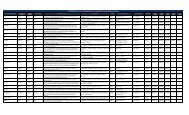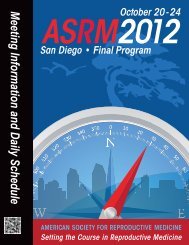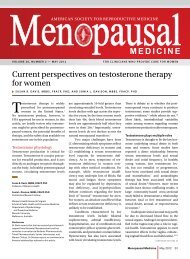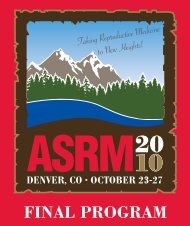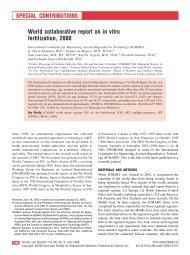scientific program • symposia - American Society for Reproductive ...
scientific program • symposia - American Society for Reproductive ...
scientific program • symposia - American Society for Reproductive ...
You also want an ePaper? Increase the reach of your titles
YUMPU automatically turns print PDFs into web optimized ePapers that Google loves.
SCIENTIFIC PROGRAM <strong>•</strong> SYMPOSIA<br />
Monday, October 17, 2011 7:00 am – 8:45 am<br />
Symposium<br />
Continental Breakfast Provided.<br />
LONG-TERM MANAGEMENT OF SYMPTOMS<br />
OF ENDOMETRIOSIS<br />
Robert S. Schenken, M.D. (Chair)<br />
The University of Texas Health Science Center<br />
Serdar E. Bulun, M.D.<br />
Northwestern University<br />
John F. Steege, M.D.<br />
University of North Carolina Medical School<br />
Needs Assessment and Description<br />
Endometriosis is a chronic disease that can be treated<br />
both surgically and medically. A current ASRM Practice<br />
Committee Guideline states that “Endometriosis should<br />
be viewed as a chronic disease that requires a life-long<br />
pain management plan with the goal of maximizing the<br />
use of medical treatment and avoiding repeated surgical<br />
procedures.” In a 2009 survey of the ASRM membership,<br />
about one-third believes they need additional in<strong>for</strong>mation<br />
about the management of women with endometriosis.<br />
The <strong>American</strong> College of Obstetrician and Gynecologists<br />
(ACOG) released a practice bulletin in July 2010<br />
“recommending conservative nonsurgical treatment<br />
approach <strong>for</strong> treating women with endometriosis-associated<br />
pain followed by more invasive procedures if these fail to<br />
alleviate pain”. This symposium will address the long-term<br />
management of endometriosis, with detailed discussion of<br />
the benefits and risks of surgical versus medical therapies in<br />
designing long-term treatment plans <strong>for</strong> patients suffering<br />
from endometriosis.<br />
Learning Objectives<br />
At the conclusion of this session, participants should be able<br />
to:<br />
1. Differentiate various causes of pelvic pain prior to any<br />
therapy specific <strong>for</strong> endometriosis.<br />
2. Discuss the benefits and risks of surgery versus medical<br />
therapies such as GnRH agonists with or without “addback”<br />
therapy, oral contraceptives, progestogens, or<br />
danazol <strong>for</strong> long-term treatment of symptoms associated<br />
with endometriosis.<br />
3. Counsel patients on the efficacy of available long-term<br />
pain treatment options.<br />
4. Design and develop long-term treatment plans <strong>for</strong><br />
women suffering from endometriosis.<br />
Valencia Ballroom<br />
Supported by an independent educational grant from Abbott Laboratories.<br />
63<br />
ACGME COMPETENCY<br />
Medical Knowledge<br />
Patient Care<br />
TEST QUESTION:<br />
After participating in this session, in my practice I will:<br />
A. Use leuprolide acetate to treat an endometrioma<br />
diagnosed by ultrasound.<br />
B. Per<strong>for</strong>m laparoscopy and aspirate an endometrioma.<br />
C. Per<strong>for</strong>m laparoscopy, aspirate the endometrioma and<br />
ablate the base.<br />
D. Expectantly manage a suspected endometrioma in a<br />
patient with pelvic pain.<br />
E. Per<strong>for</strong>m laparoscopy and resect an endometrioma.<br />
F. Not applicable to my area of practice.



